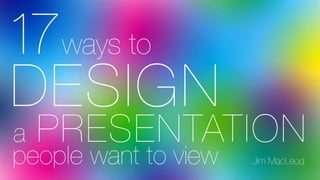
17 Ways to Design a Presentation People Want to View
- 1. 17 Ways to Design a Presentation People Want to View Jim MacLeod
- 3. They’re ineffective. Why do we keep doing them the same old way? This isn’t a guide that tells you how to add the perfect drop shadow or beveled gradient to a text box (don’t do that – it’s unprofessional). This eBook will give you an overview of how to get people to and keep them engaged. pay attention
- 4. You’re giving a presentation for a reason: to get a sale or impart information.
- 5. failed If it’s boring, the viewer tunes out and you’ve
- 6. We’ve all sat through these presentations, (and worse, we’ve all created these presentations). They’re painful and a waste of everyone’s time. People don’t pay attention. You need engagement before you get buy in. But how do you get a viewer engaged who has already seen presentations that are nearly identical? design
- 7. People have been communicating with images for tens of thousands of years longer than we have been communicating with the written word. Visual communication had a 35,000 year head start ahead of the written word1 . Our brains are better equipped to comprehend and store visual information.
- 8. Visual communication is and sticks in the memory far more effectively. An image can create an instant emotional connection. If you can link your message to the viewer’s emotional center, you’ve already won the battle. simply easier to understand
- 10. If you’re in a sales pitch, it’s unlikely that this is the first impression the viewer has of your company. But this is the first impression the viewer has of you. You wouldn’t wear shlubby clothes to a meeting like this. Why dress up your pitch in an ugly suit? Wrap your message in a professional package that shows that 1) you take this seriously 2) you know what you’re talking about.
- 11. cover the The cover is the single most important piece
- 12. For those of you giving a presentation, it’s possible that your cover slide could be on display for the entire lead up/introduction to the presentation. During this time, the audience could be analyzing and dissecting your cover. You might be giving a five minute overview of who you are and what you’re going to cover. What you don’t want is the audience to be distracted by a bad typeface or image. It’s the first impression your audience will have of you and what you have to say.
- 13. If you’re creating a presentation that will only live online, the cover is the single most important piece. The cover determines whether the viewer clicks to view more or they ignore it. You could have the answers to the greatest questions in the universe, but if they’re hidden behind a bad cover, nobody will ever find them.
- 14. visual theme have a Each slide should look like it’s part of the same story. A consistent design theme keeps the viewer engaged.
- 15. The cover will set the tone for your presentation. Once you determine the font and color palette (more on these later), stick with it. You’ve seen presentations where it’s obvious that the deck was Frankensteined together from other decks. One or two great slides can really ruin it for the rest of the slides. Don’t give the viewer any excuse to stop paying attention to your message. If your presentation is broken up into different sections, feel free to give each section a related visual theme. By slightly altering the color, you can let the viewer know that they are now in a different section, but it’s clearly part of the same presentation. Think of these as chapters of a book. When to break this rule: When you really want a key point to be recognized. (like this) Want to read more? Check out the eBook at ebri.us/PPTDesign
